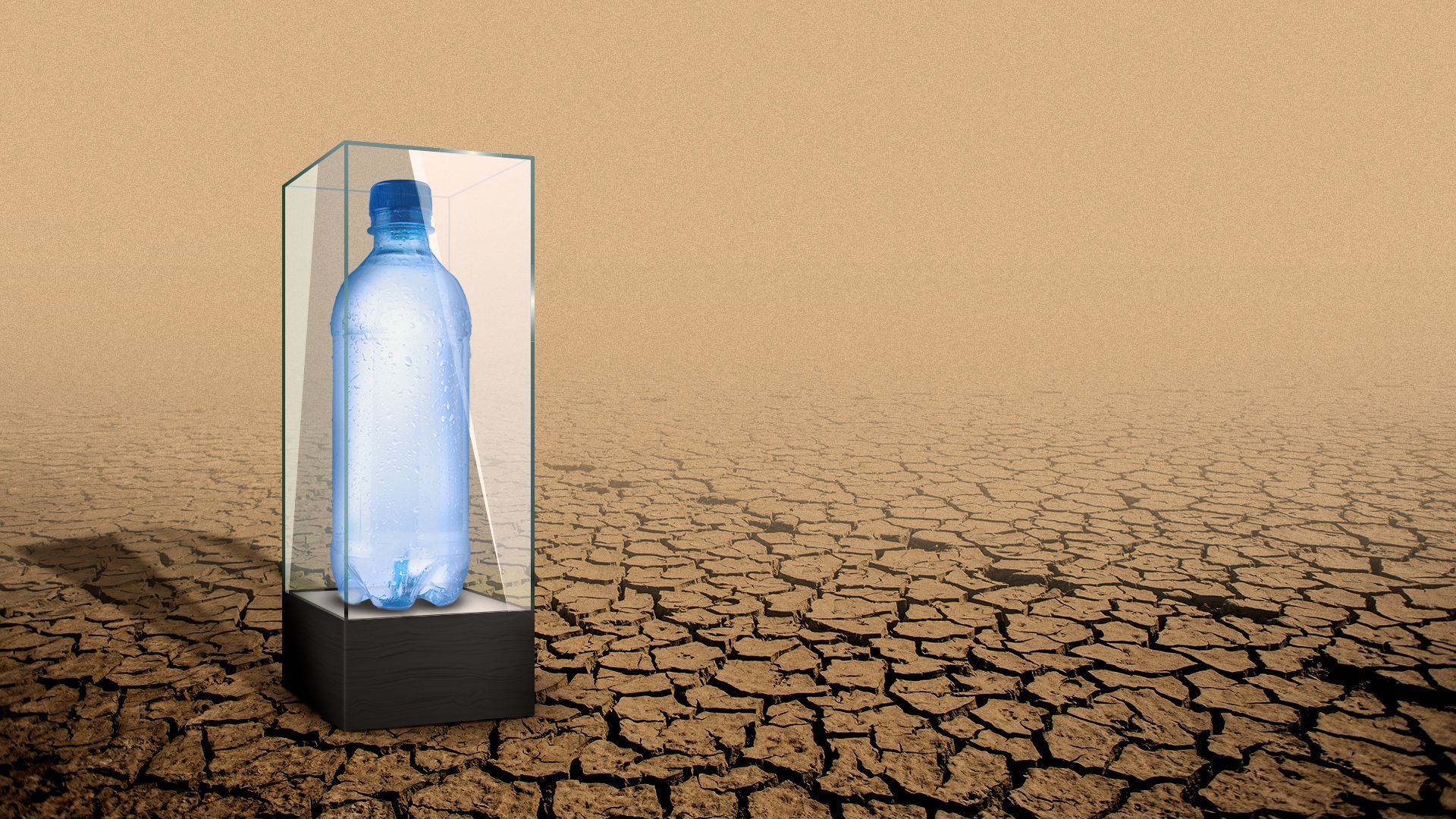| | | | | | | Presented By Foundation Medicine | | | | Axios Science | | By Alison Snyder · Nov 17, 2022 | | Thanks for reading Axios Science. This week's newsletter is 1,533 words, about a 6-minute read. | | | | | | 1 big thing: Water insecurity's untold toll |  | | | Illustration: Aïda Amer/Axios | | | | Hundreds of millions of people around the world lack reliable access to safe water — an escalating crisis with a potentially profound impact on their mental health, Eileen and I write. Why it matters: Similar to food insecurity, water insecurity has been linked to depression, anxiety, and increased rates of violence — and is considered one of the greatest threats facing humans, several scientists tell Axios. - Water insecurity can be caused by numerous factors, including geology, poor infrastructure, high demand from a population or industry, racism, or extreme drought or intense flooding fueled by climate change.
- "A lot of water insecurity data worldwide measures household water connections or the percentage of homes that have piped water," says Natalie Exum, who studies the health impacts of water insecurity at Johns Hopkins University.
- "We're not capturing a lot of the stress and burden" that comes with it, she says.
- A challenge is zeroing in on who is experiencing water insecurity — and how it affects their mental health.
What's new: Northwestern University researchers sought to better understand who is water insecure by going beyond "measuring water in terms of what we can touch ... to measuring individual experiences," says study co-author Sera Young, associate professor of anthropology and global health. - Her team surveyed 45,555 adults in 31 low- and middle-income countries in sub-Saharan Africa, North Africa, Asia and Latin America, between Sept. 4, 2020, and Feb. 24, 2021.
- Those surveyed were asked 12 questions about their experience, including how often they worried about not having enough water or changed their diet because of drought or floods, and how access affects their emotional health.
- The team found 14% of those surveyed were water insecure, ranging from 4% in China to 64% in Cameroon. This means an estimated 436 million adults — out of 3 billion represented in those regions — were water insecure during that time period.
Yes, but: The number of countries examined in that study is small and the questions didn't capture some key dimensions like water quality, says Amber Wutich, president's professor of anthropology at Arizona State University. - But, she says it's a "very good first step" toward the much-needed effort of quantifying the global extent of water insecurity at an individual level.
The big picture: Water insecurity occurs worldwide, including in high-income countries or nations with high rainfall totals, Young says. - This includes the U.S., where climate change, an aging pipe system and systemic racism play a large role.
- Certain municipalities intentionally excluded low-income areas from participating in centralized water infrastructure — impacting mostly Black, Native American, and Hispanic populations, Wutich says.
The impact: Mental health outcomes from water insecurity are still being studied but many scientists think "experiences of resource insecurity seem to track closely with PTSD, anxiety and depression," Wutich says. - The role of climate change in water insecurity — and its impact on mental health — is an area of intense interest.
- The latest IPCC report released earlier this year found that "climate change is expected to have adverse impacts on wellbeing and to further threaten mental health."
- Droughts, floods and other climate-related exposures "were associated with psychological distress, worsened mental health, and higher mortality among people with pre-existing mental health conditions, increased psychiatric hospitalizations, and heightened suicide rates," scientists wrote last year.
But there are multiple mechanisms for how climate change can affect someone's health, says Tarik Benmarhnia, a UC San Diego professor who studies the impact of climate change on health. - Extreme weather events can directly cause distress or trauma if someone witnesses injuries or death. But these events can also affect other mental health factors, including employment, housing and nutrition, says Alessandro Massazza of the Wellcome Trust.
- We need to be "specific about the mechanism so we can formulate very specific policies," Benmarhnia says.
|     | | | | | | 2. Newly forming star shines in JWST photo |  | | | The protostar L1527. Photo: NASA, ESA, CSA, and STScI. Image processing: J. DePasquale, A. Pagan, and A. Koekemoer | | | | A newly forming star typically hidden behind clouds of dust has been revealed in a new photo from the James Webb Space Telescope, Axios' Miriam Kramer writes. Why it matters: Studying protostars like this one provides a window into how our Sun and solar system began billions of years ago. What's happening: The protostar L1527 — in the neck of the hourglass — is framed by blue, red and orange clouds of material. That material has cavities carved through it by matter expelled by L1527. - The dark line at the neck of the hourglass is the protoplanetary disk of gas and dust around the protostar and could be clumping together in the earliest stages of planet formation, according to NASA.
- The protostar itself is estimated to be only about 100,000 years old.
- "L1527 doesn't generate its own energy through nuclear fusion of hydrogen yet, an essential characteristic of stars," NASA said in a statement. "Its shape, while mostly spherical, is also unstable, taking the form of a small, hot, and puffy clump of gas somewhere between 20 and 40% the mass of our Sun."
The big picture: The JWST looks out into the universe largely in infrared light, allowing it to cut through gas and dust, revealing objects that are difficult to see with other space telescopes or observatories on Earth. |     | | | | | | 3. Lab-grown meat gets first FDA signoff |  | | | Illustration: Eniola Odetunde/Axios | | | | Lab-grown poultry from a California startup is safe for human consumption, the Food and Drug Administration said, Axios' Herb Scribner reports. Why it matters: It's a milestone for cell-cultivated meats and could be a sign these foods will be available in U.S. stores and restaurants. Driving the news: The FDA said yesterday it completed its first pre-market consultation of human food developed from cultured animal cells and "has no further questions at this time" about the food's safety. - The startup Upside Foods, which develops cell-grown chicken, provided information to the FDA based on food made from cultured chicken cells.
- These foods could become more commonplace in the U.S. market "in the near future," the FDA said.
- Before the food can enter the market, the facility where it's made needs to meet U.S. Department of Agriculture and FDA standards, the FDA said. The food itself will also need a full USDA inspection.
Catch up quick: Recent advancements in cell-culture technology have helped food developers use animal cells to produce food. Within the last three years, the FDA and the USDA agreed to regulate these cell-cultured meats. - "The FDA is ready to work with additional firms developing cultured animal cell food and production processes to ensure their products are safe and lawful," said FDA commissioner Robert Califf and Susan Mayne, director of the FDA's Center for Food Safety and Applied Nutrition, in a statement.
The big picture: Multiple startups are now working to produce animal protein by growing animal cells. But this type of food is still experiencing growing pains. For example, officials are unsure what to call it. - The increase in production comes amid a fake-meat boom, which could grow by 10x by 2029, Barclays analysts estimated in 2019.
|     | | | | | | A message from Foundation Medicine | | Prostate, lung and colorectal cancers make up about 43% of cases in men | | |  | | | | During Men's Health Awareness Month, we recognize each unique patient. Foundation Medicine tests accelerate treatment development and streamline research efforts around the globe. Learn more about our commitment to providing the insights needed to take action for patients. | | | | | | 4. Worthy of your time | | The surprising afterlife of unwanted atom bombs (William J. Broad — NYT) A new tick-borne disease is killing cattle in the U.S. (Britta Lokting — MIT Tech Review) This is how an Alzheimer's gene ravages the brain (Elie Dolgin — Nature) How to make corn more like cactus (Kurt Kleiner — Knowable) |     | | | | | | 5. Something wondrous |  | | | A grasshopper feeding triggers calcium ion signals in pulvini and leaflet movements. Credit: Masatsugu Toyota/Saitama University | | | | A longstanding puzzle in plant physiology centers on how — and why — some plants can rapidly move their leaves. A new study finds chemical and electrical signals prompt the leaves of the mimosa, or "sensitive plant," to quickly fold and protect the plant from insect attacks. The big picture: Plant movement has intrigued scientists for centuries, and captured the attention of Charles Darwin himself. - Over the past few decades, scientists have put forth ideas about the mimosa's movement, suggesting it could scare insects, reveal the plants' thorns or downplay their size to predators.
- More recently, researchers have found calcium signals are involved in plants' responses to being broken or wounded, hinting they might have a role in triggering the rapid movements of the mimosa, Masatsugu Toyota, an author of the new study, told me in an email.
What's new: Toyota and his colleagues developed fluorescent Mimosa pudica plants to track the movement of calcium ions through the plant when they were touched or wounded. They also recorded electrical signals in the plant. - They found the leaves closed 0.1 seconds after calcium ions arrived in the pulvini, thick areas at the base of leaves that help them move.
- When the leaves were treated with chemicals that block the signals, they didn't move when the plant was wounded, they reported this week in Nature Communications.
The scientists then used CRISPR gene editing to create mimosa plants without pulvini. - They found grasshoppers were more likely to eat the plants that couldn't move than wild mimosa.
- When grasshoppers fed on the plants, the leaves moved with the calcium signals and the grasshopper stopped eating and left the plant.
- The finding suggests leaf movement protects the plant from insect attacks, the researchers write.
Yes, but: One limitation of the study is the researchers don't know "how the leaf movements block the insect feeding/appetite," Toyota, a professor of plant physiology at Saitama University in Japan, wrote in the email. What's next: The researchers plan to study how calcium ions help control leaf movements in the plant. |     | | | | | | A message from Foundation Medicine | | Cancer survivorship is on the rise | | |  | | | | The number of cancer survivors in the U.S. is projected to increase to 22.2M by 2030, according to NIH. The strategy: Foundation Medicine is transforming care by using genomic sequencing to help oncologists connect patients with targeted treatments for their specific cancer type. Learn more. | | | | Big thanks to Laurin-Whitney Gottbrath for editing this newsletter, to Aïda Amer on the Axios visuals team and to Carolyn DiPaolo for copy editing this edition. |  | | Are you a fan of this email format? Your essential communications — to staff, clients and other stakeholders — can have the same style. Axios HQ, a powerful platform, will help you do it. | | | | | | Axios thanks our partners for supporting our newsletters. If you're interested in advertising, learn more here.
Sponsorship has no influence on editorial content. Axios, 3100 Clarendon Blvd, Arlington VA 22201 | | | You received this email because you signed up for newsletters from Axios.
Change your preferences or unsubscribe here. | | | Was this email forwarded to you?
Sign up now to get Axios in your inbox. | | | | Follow Axios on social media:    | | | | | |








No comments:
Post a Comment